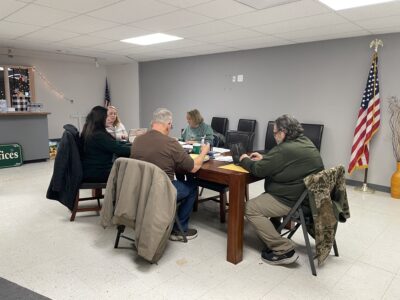Raising Awarenes: City Pastor, Family Raise Awareness Of MPS

Julia Eppehimer Rexford, Joella Eppehimer Liddle, Mayor Kim Ecklund, the Rev. Wayne Eppehimer and Joan Eppehimer are pictured. Ecklund is proclaiming Thursday, May 15, MPS Awareness Day and has ordered City Hall to be lit in purple, the color used to represent the National MPS Society.
- Julia Eppehimer Rexford, Joella Eppehimer Liddle, Mayor Kim Ecklund, the Rev. Wayne Eppehimer and Joan Eppehimer are pictured. Ecklund is proclaiming Thursday, May 15, MPS Awareness Day and has ordered City Hall to be lit in purple, the color used to represent the National MPS Society.
- Dr. Joseph Muenzer, a research physician who is researching treatments and a cure for MPS II, is pictured with the Rev. Wayne Eppehimer and his wife, Joan, as well as the Zebra mascot for rare disease.
When Jamestown residents, Rev. Wayne and Joan Eppehimer, were married back in 1980 they had never even heard of mucopolysaccharidosis (MPS). They only knew that Eppehimer had something called Hunter syndrome and that was why his joints were all large.
That same year, Eppehimer’s sister, Sharyn Madison, began to notice that her three-year-old son was exhibiting traits similar to what she had seen in her brother’s disease. Madison’s son was tested at John Hopkin’s for Hunter syndrome and the test results came back positive. A doctor got her in touch with the National MPS Society and a whole new world of medical understanding opened for the family.
It turned out that Hunter syndrome was one of 11 different kinds of MPS, designated as mucopolysaccharidosis type II (MPS II). There were no treatments available at the time, but researchers were studying the diseases and hoping to develop treatments.
Each type of MPS lacks a different lysosomal enzyme. The lysosomes are the recycling center of every cell. There are approximately 60 different enzymes the lysosomes use to break down food inside the cell. With one of these enzymes lacking in MPS patients the result is that some of the cell’s food is undigested. The term for this undigested, or unrecycled food is glycosaminoglycan (GAG). GAGs accumulating in every cell throughout a patient’s life causing progressive damage as the buildup grows. There is also a similar type of storage disease called ML that is also under the National MPS Society umbrella.

Dr. Joseph Muenzer, a research physician who is researching treatments and a cure for MPS II, is pictured with the Rev. Wayne Eppehimer and his wife, Joan, as well as the Zebra mascot for rare disease.
For Eppehimer and his nephew, the disease was attenuated, or mild. More than 60 per cent of children who are born with MPS II are on the other end of the spectrum and have debilitating symptoms. All children with MPS diseases begin life developing normally. As early as one-year children severely affected may show signs of developmental delay. Between eighteen months and two years of age, children with non-attenuated MPS diseases begin to regress. They lose their ability to walk, what little speech they had disappears, and other physical skills and mental ability decline.
In the United States and around the world, MPS research has come a long way since 1980 when Eppehimer and his sister had never heard the term. Today, there are enzyme replacement therapies for five of the MPS diseases. None of these therapies can reverse damage done, but they do slow the progression of the disease. There are some new therapies in the pipeline which will cross the blood-brain barrier which will help those children with the sever forms of MPS, and therapies are being researched for the MPS types that still lack treatments.
Currently the United States boasts a robust National MPS Society and a center for MPS research and treatment was recently opened in Chapel Hill, NC. The Center is named after Dr. Joeseph Muenzer, a research physician who dedicated his entire career to working on treatments and a cure for MPS II. The Muenzer MPS Research & Treatment Center is part of the UNC Health Children’s care in Chapel Hill.
To learn more about this family of diseases visit the National MPS Society at https://mpssociety.org/
In commemoration of this day, Mayor Kim Ecklund has issued a proclamation declaring May 15 as MPS Awareness Day and has ordered City Hall to be lit in purple, the color used to represent the National MPS Society.






